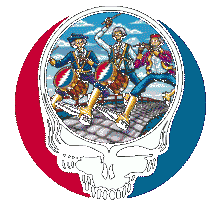Grateful Dead Caucus 2007
 Steve Gimbel, a philosopher at Gettysburg College, blogged about this year’s Caucus over at Philosophers’ Playground
Steve Gimbel, a philosopher at Gettysburg College, blogged about this year’s Caucus over at Philosophers’ PlaygroundCheck out his blog!
A wonderful conference last week in Albuquerque, the 10th annual gathering of the Grateful Dead Caucus as a part of the annual meeting of the Southwest/Texas Association of Popular and American Culture. Reflections from my first time as a part of the caucus:
Paper
Covering four days -- from 8 am to 8 pm on Thursday and Friday -- there seems to be no lack of interest in taking the Dead phenomenon seriously by academics. Covering a very wide range of methodologies in the humanities and social sciences, the papers were universally of a very high quality. Papers generally grouped themselves around a couple of general themes:
History
A wonderful series of papers discussing historical aspects of the Dead, the Haight, and the movement. Starting off was co-chair Gary Burnett's examination of the complete run of the neighborhood newspaper the Oracle and its relation to and mentions of the Dead showing at first a bi-polar stance both embracing and deprecating hippie music showing a tension between the beat and hippie factions of the early counter-culture. Rick Dodgson read "From Soquel to San Jose: The First Acid Tests"
Grateful Dead and Spirituality
Several papers discussing the spiritual nature of the Dead experience. Thursday's panel featured Mary Goodenough's "In and Out of the Garden: Sacred and Profane in Deaddom," Paul Gass' "Buddhism Through the Eyes of the Dead," and Dave Bryan's "Grateful Dead Theology," while Saturday brought Kent Elliot's "The Lie Breathed Through Silver." All began from the fact of broad spiritual experience amongst Deadheads at shows and then tried to make sense of this phenomenological data. By examining the relation between lyrics and religious traditions or looking at the experience itself, the hope was to make the "it" that so many point to more clear. Discussion around this topic was spirited, if not spiritual.
Deadhead Culture
Sociologists Rebbecca Adams and Alan Lehman gave fascinating discussions of Deadhead demographics, the former from data gathered at the 1998 Further festivals and the latter at 1991 shows at RFK and Giants Stadium. Nicholas Merriwether gave an incredibly well documented discussion of Deadhead pipecraft, locating it in the historical tradition of pipecraft through the centuries. Elizabeth Carroll gave a fascinating approach to interpreting the scene as a whole (both good and bad) viewing through the Greek notion of a pharmakon -- the word for both remedy and poison -- in her paper "Is Destruction Loving's Twin?: The Grateful Dead Pharmakon." The continental philosophical duo of Jim Tuedio and Stan Spector read their papers "All Ears, All Body: The Strange Attraction in Nonlinear Musical Embodiment" and "And The Music Played the Band: The X Factor, Merleau-Ponty, and the Chiasm" that sought to understand the phenominological embodiment of the process of Being when engaged in what the Germans call Mithoeren (hint: if you don't understand continental philosophy, just say something in Greek, German, or French). My own contribution looked at the nature of the economy in the parking lot.
Comparative Musicology
There were a number of papers that sought to reconcile the music of the Dead with the larger body of American popular music. Eric Levy and Jay Williams both compared the Dead to representatives of the experimental and avant-garde movements, Eric focusing on John Cage and Jay upon Frank Zappa, while Matt Armstrong looked at the Dead's influence in the work of Ryan Adams. Chris Norden compared the lyrics of Bob Dylan and Robert Hunter in terms of their use of weather metaphors. Christian Crumlish examined the unmentioned influence of the Dead on artists through the decades in his "Please Forget You Knew My Name: Secretly Influenced by the Dead." Pam Hunt, Liz Yeager, and Jake Cohen gave contrasting views of the political presuppositions in post-Dead, contemporary jamband culture with their papers "Are You Kind?: The Relationship between Behavior, Meanings, and Levels of Involvement and Ideological Embeddedness in the Jamband Subculture," "My Band is Better Than Your Band: Inside America's Jamband Scene," and "Jamband's and Sonata Form." Barry Smolin focused on freak folk, contemporary psychedelic music that eschews improvisation and David Gans in "Anti-Dead and Meta-Dead" looked at music about the band both laudatory and negative.
Other
Papers that defy categorization included Mark Mattson's magnificent cataloging of every performed error in the playing of "Here Comes Sunshine" and Mel Belleville's fictional expansion of the storylines of "Jack Straw," "Loser," and "Friend of the Devil."
Rock
We were treated to several wonderful performances. Wednesday night was a triple bill at the District Bar and Grill of Dave Bryan's Chickenstand Throw-DownBand, David Gans, and Liquid Gypsy. David Gans played a second set at Friday night's house party and if he wasn't completely pleased with the performance, his opinion was far in the minority.
Scissors
Perhaps the highlight of the conference was the appearance of John Perry Barlow as the conference's keynote speaker. Mesmerizing the crowd with wit, intelligence, and his abilities as a storyteller, Barlow was simply amazing. Generous with his time as well, he hung out and shot the breeze with us at the infamous Hotel Blue on Thursday night and at the airports in Albuquerque and Houston on Saturday.
An incredibly successful conference by any measure. I want to personally thank everyone there for being so incredibly welcoming of the new folks like myself and especially to the session chairs, Nick and Gary, I just have to say thank you for a real good time.
All I can say is WOW!



1 Comments:
Thanks for the mention!! :)
Pam
Post a Comment
<< Home